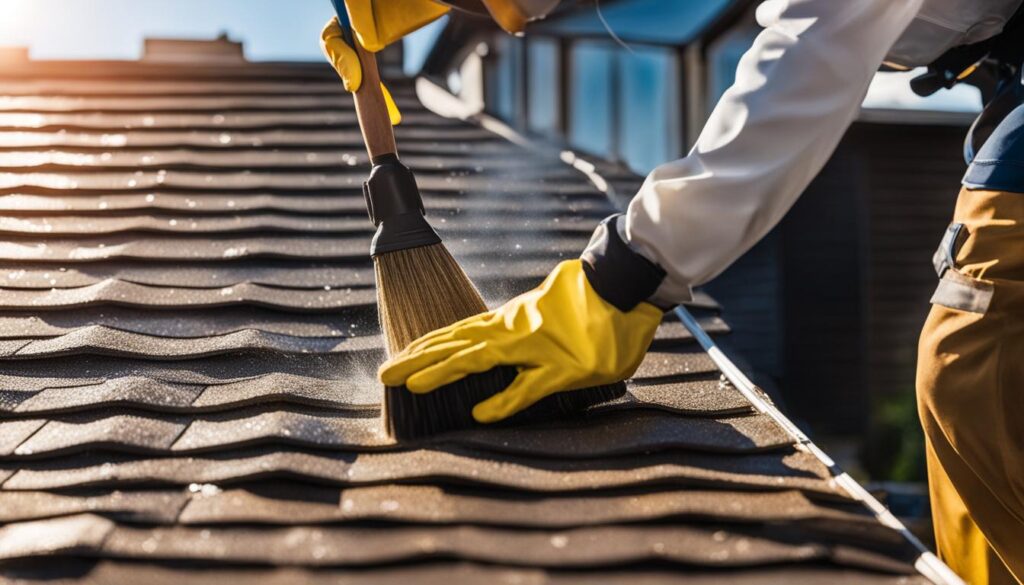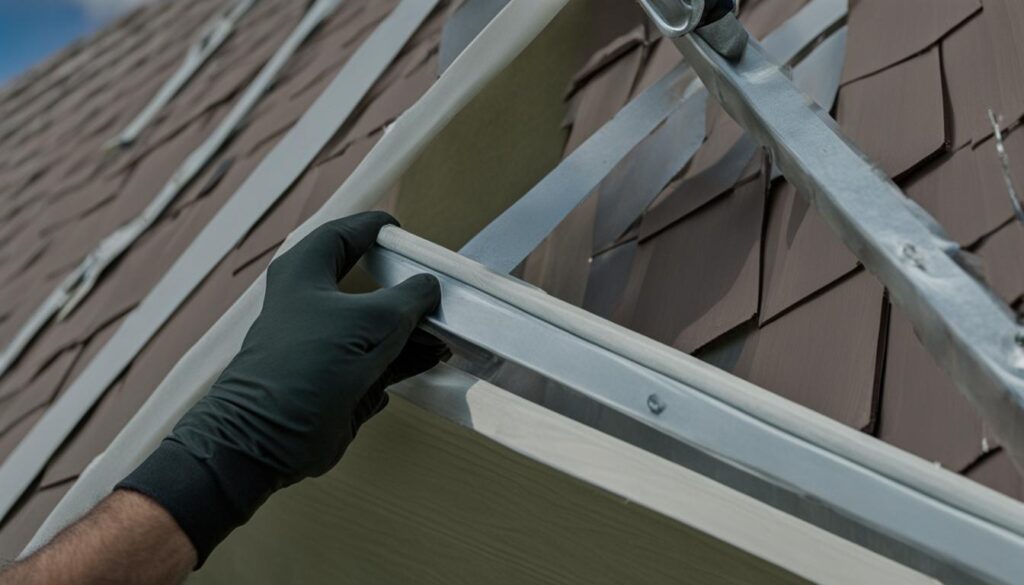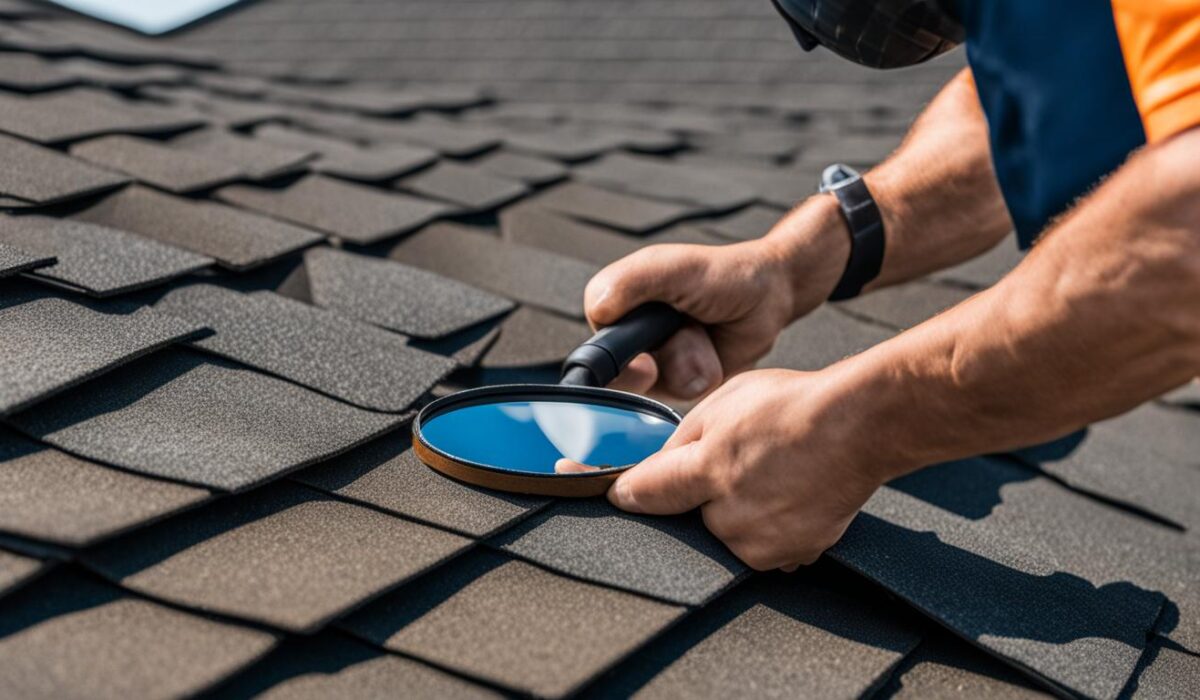Your shingle roof is one of the most vital parts of your home’s exterior, protecting it from the elements. However, it can also be one of the most vulnerable, which is why regular maintenance is crucial to keep it in optimal condition.
By following the expert advice in this guide, you can learn how to maintain your shingle roof properly and preserve its durability, weather resistance, and overall functionality for years to come. Whether you are a new homeowner or have owned your home for years, this article will provide you with the essential maintenance tips you need to know.
Key Takeaways:
- Regular maintenance is essential for protecting your shingle roof from potential damage.
- Proper cleaning, clearing debris and gutters, and addressing shingle damage can prevent costly repairs.
- Regular inspections and preventative maintenance practices can help detect and prevent roof leaks.
- The right maintenance schedule can help extend the lifespan of your shingle roof.
- Professional shingle roof maintenance companies can provide additional support and services to ensure your roof stays in top condition.
Importance of Regular Maintenance
Regular maintenance is crucial to extend the lifespan of your shingle roof and prevent costly repairs in the future. By following a proper maintenance routine, you can ensure that your roof remains in good condition, protecting your home from potential damage.
Why Regular Maintenance is Important
Shingle roofs are designed to withstand extreme weather conditions, but they need proper care and maintenance to perform their best. Without regular maintenance, your shingle roof can deteriorate faster, leading to water leaks, mold growth, and more significant damage to your home.
Regular maintenance can help you:
- Identify and address potential issues before they turn into major problems
- Extend your shingle roof’s lifespan and avoid costly repairs or replacement
- Keep your home protected from water damage, mold, mildew, and other types of damage
The Roof Maintenance Checklist
Here’s a comprehensive roof maintenance checklist to follow:
| Task | Frequency |
|---|---|
| Inspect your roof for visible damage, such as cracks or missing shingles | At least twice a year, in the spring and fall |
| Clean your gutters and downspouts | At least twice a year, in the spring and fall |
| Remove debris, such as branches or leaves, from your roof and gutters | As needed, after strong wind or heavy rain |
| Trim trees near your roof to prevent branches from falling and damaging your shingles | As needed, at least once a year |
| Check your attic for proper ventilation and insulation | At least once a year |
By following this checklist, you can maintain your shingle roof’s performance and prevent damage caused by neglect.
Remember: Proper shingle roof maintenance is essential for protecting your home and saving money on repairs or replacement. Stay proactive and follow the recommended maintenance routine to keep your roof in good condition.
Inspecting Your Shingle Roof
Regular inspections are essential for maintaining your shingle roof’s longevity and ensuring it remains in optimal condition. By implementing these useful shingle roof maintenance tips, you can identify minor issues before they escalate into more significant problems that necessitate costly repairs.
Start by visually inspecting your roof from the ground for any apparent damage or issues, such as missing or lifted shingles, cracks, and mold growth. Next, use a ladder to climb on top of the roof safely while wearing appropriate footwear to walk across it carefully.
Once on the roof, examine the shingles for any signs of wear and tear, such as chips, cracks, dents, or curling. If your shingles are extensively damaged, you may require professional shingle roof maintenance services to replace them to prevent further damage.
Make sure you inspect your roof’s flashing, the metal strips installed around roof protrusions like chimneys, vents, and skylights. Flashing prevents water from penetrating through the roof and causing damage to your home’s interior. Damaged flashing can result in water leaks, so make sure to inspect it and repair or replace it if needed.
Don’t forget to inspect the gutters and downspouts for debris build-up that can lead to water overflow and cause damage to your roof and home. Remove any leaves, twigs, and other debris from the gutter and downspout to ensure water flows freely away from your home.
Inspection Checklist:
| What to Inspect | When to Inspect |
|---|---|
| Missing or lifted shingles | Annually, after a severe storm or high winds |
| Shingle damage (chips, cracks, dents, curling) | Annually, or after severe weather conditions |
| Flashing damage or deterioration | During annual inspections or after strong winds/storms |
| Gutter debris or clogging | Spring and fall annually or as needed |
By following this shingle roof maintenance guide, you can ensure that your shingle roof remains in excellent condition, prolonging its lifespan and protecting your home from potential water damage. Remember to schedule regular inspections and address any issues promptly to prevent costly repairs in the future.
Cleaning Your Shingle Roof
Proper maintenance of your shingle roof requires regular cleaning. Dirt, debris, and leaves can accumulate on the roof and reduce its effectiveness over time. Cleaning also helps identify any potential issues or damage that may be hidden underneath. Below are some best practices for cleaning your shingle roof:
- Start by removing any leaves or debris from the roof using a broom or leaf blower.
- Inspect the roof for any visible damage, including cracked, missing, or loose shingles.
- Use a mild cleaning solution to remove any dirt or stains on the shingles.
- Use a low-pressure washer to rinse the roof, being careful not to damage the shingles.
- Clean the gutters and downspouts to ensure they are free from debris and can properly drain water away from the roof.
If you’re uncomfortable performing these tasks yourself, consider hiring a shingle roof maintenance company to handle the job for you. These companies offer a range of services, including cleaning, inspections, and repairs to ensure your roof stays in top condition. By investing in professional shingle roof maintenance services, you can save time and money in the long run by preventing costly repairs or replacements.

Clearing Debris and Gutters
Regular gutter cleaning and debris removal are crucial shingle roof maintenance best practices to ensure the longevity of your roof. Debris build-up can clog gutters, leading to water penetration, leaks, and damage to your shingle roof. Therefore, it’s essential to clean the gutters at least twice a year, preferably in spring and fall, to prevent debris accumulation.
You can use a ladder to access the roof and hand tools to remove debris from gutters. Remove all the leaves, twigs, and other debris from the gutters to keep the water flowing freely. You can also use a garden hose to flush out any remaining debris. However, if you’re uncomfortable accessing your roof or gutters, seeking the services of a professional shingle roof maintenance company might be advisable.
To further prevent debris from accumulating on your shingle roof, you can trim any overhanging branches or limbs. Falling debris can damage your shingle roof and require costly repairs. Therefore, trim any overhanging branches regularly, and keep your roof free of debris.
Addressing Shingle Damage
When it comes to shingle roofing, damage is a common issue that can occur over time and compromise the integrity of your roof. There are several types of shingle damage that can occur, including:
- Cracking
- Curling
- Blistering
- Missing shingles
The potential causes of shingle damage include:
- Age
- Weather exposure
- Poor installation
- Lack of maintenance
If left unaddressed, shingle damage can lead to water leaks and costly repairs. The costs of shingle roof maintenance will vary depending on the extent of the damage and the type of repair required. Minor repairs can cost as little as $100, whereas major repairs or replacement can cost upwards of $7,000.
If you notice any signs of shingle damage, such as cracks, curling, or missing shingles, it is crucial to address them promptly. Ignoring the problem can lead to more extensive damage and higher shingle roof maintenance costs in the long run.
Preventing Roof Leaks
One of the most common problems that can arise in a shingle roof is a leak. A roof leak can cause significant damage to your home and lead to costly repairs. To prevent roof leaks, it is crucial to follow the best practices for shingle roof maintenance. Here are some tips:
Regular Inspections
Regular inspections are essential for identifying any potential issues before they escalate into major problems. Inspect your roof at least twice a year, in the spring and fall, to check for any signs of damage or wear and tear. Look for missing or damaged shingles, cracked caulking, or any holes or cracks in the roof.
Maintenance Practices
In addition to regular inspections, there are specific maintenance practices that can prevent roof leaks. Keep your gutters and downspouts clean and clear of debris, as clogged gutters can cause water to back up and seep into your roof. Trim any overhanging branches that may fall onto your roof during a storm. And, make sure that your attic is properly insulated and ventilated, as temperature changes can cause the roof to expand and contract, potentially leading to leaks.
Hire a Professional
If you are uncomfortable inspecting or maintaining your shingle roof, consider hiring a professional shingle roof maintenance company. A professional can provide a thorough inspection and identify any potential issues that may lead to a roof leak. They can also perform any necessary repairs or maintenance to ensure the longevity of your shingle roof.

Extending the Lifespan of Your Shingle Roof
To extend the lifespan of your shingle roof, it’s important to follow a consistent maintenance schedule. This can help you identify any issues early and prevent costly repairs down the road. Here are some recommended maintenance tasks and their proper timing:
| Maintenance Task | Timing |
|---|---|
| Inspect your roof | Twice a year, in the spring and fall |
| Clean your roof and gutters | Annually, in the spring |
| Clear debris from your roof and gutters | As needed, after storms or heavy winds |
| Address any shingle damage | As soon as it’s identified |
In addition to these tasks, it’s important to note any changes to your roof’s appearance or performance. For example, if you notice your shingles are curling or cracking, or if your roof is leaking, it’s important to address these issues promptly. By following a regular maintenance schedule and addressing issues as they arise, you can help extend the lifespan of your shingle roof.
Tip: If you’re unsure about the proper maintenance schedule for your particular roof, consult with a professional shingle roof maintenance company. They can provide recommendations and help ensure that your roof stays in top condition.
Professional Shingle Roof Maintenance
If you’re not confident in your shingle roof maintenance skills or simply don’t have the time, it’s worth considering hiring a professional shingle roof maintenance company. These companies offer a range of services that can keep your roof in great shape, including:
| Service | Description |
|---|---|
| Inspections | Regular inspections to identify and fix any issues before they become major problems. |
| Cleaning | Professional cleaning services to remove debris and dirt buildup that can damage your shingle roof over time. |
| Repairs | Skilled technicians can quickly and effectively fix any damage to your shingle roof, extending its lifespan and preventing further damage. |
| Maintenance Plans | Professional shingle roof maintenance companies can create customized maintenance plans tailored to your specific roof and needs, ensuring you get the best possible care. |
By hiring a shingle roof maintenance company, you can save time, avoid potential injuries from performing maintenance yourself, and ensure that your roof is always in top condition. Moreover, professional services can be more efficient as they have the required tools and experience to handle roofing challenges efficiently and effectively.
Make sure to do your research and select a reputable shingle roof maintenance company for the best results. Check their experience, licenses, insurance, and ensure they have a good track record. By doing so, you can trust that your roof will be in safe hands and be properly cared for.
Conclusion
Taking care of your shingle roof is crucial to ensure that it remains durable and weather-resistant for years to come. This article has provided you with essential tips and best practices for shingle roofing maintenance, including inspecting and cleaning your roof, clearing debris and gutters, addressing shingle damage, and preventing roof leaks.
By following a consistent maintenance schedule and addressing any issues promptly, you can prevent costly repairs and extend the lifespan of your shingle roof. Remember that if you prefer to leave the maintenance tasks to professionals, there are shingle roof maintenance companies that offer various services to help you keep your roof in top condition.
We hope that this article has been informative and helpful in guiding you through the process of maintaining your shingle roof. Remember to schedule regular inspections and keep up with the recommended maintenance tasks to protect your home and ensure the longevity of your shingle roof.
FAQ
What are the essential shingle roofing maintenance tips?
The essential shingle roofing maintenance tips include regular inspections, cleaning your roof, clearing debris and gutters, addressing shingle damage, preventing roof leaks, and following a maintenance schedule. These practices will help protect your shingle roof from potential damage and prolong its lifespan.
Why is regular maintenance important for a shingle roof?
Regular maintenance is crucial for a shingle roof to prolong its lifespan and prevent costly repairs. By conducting regular inspections and addressing any issues promptly, you can identify potential problems early on and prevent them from escalating into major damages. It also helps maintain the roof’s structural integrity and ensures it stays weather-resistant.
How do I inspect my shingle roof?
To properly inspect your shingle roof, start by checking for any signs of damage such as missing or cracked shingles. Look for areas with potential leaks, check the flashing around chimneys and vents, and examine the condition of the gutters and downspouts. It’s recommended to get on the roof and visually inspect it or hire a professional to do a comprehensive roof inspection.
How do I clean my shingle roof?
Cleaning your shingle roof involves removing debris, moss, and algae. Use a soft-bristle brush and water to scrub away any dirt or organic growth gently. Avoid using high-pressure water or harsh chemicals as they could damage the shingles. If you’re unsure about the process, it’s best to hire professional shingle roof maintenance services to ensure safe and effective cleaning.
How do I clear debris and gutters from my shingle roof?
It’s important to regularly clear debris from your shingle roof to prevent water buildup and potential damage. Use a rake or broom to remove leaves, branches, and other debris. Additionally, ensure that your gutters are clean and free of clogs. Clogged gutters can lead to water overflow, causing damage to both the roof and the foundation of your home.
What should I do if I notice shingle damage?
If you notice shingle damage, such as missing, cracked, or curling shingles, it’s crucial to address it promptly. Contact a professional shingle roof maintenance company to assess the damage and recommend the necessary repairs. Ignoring shingle damage can lead to water leaks and further deterioration of your roof.
How can I prevent roof leaks?
To prevent roof leaks, it’s important to follow proper shingle roof maintenance best practices. Conduct regular inspections to identify and address any potential issues. Keep your gutters clean and ensure adequate ventilation in your attic to prevent moisture buildup. Promptly repair any shingle damage and consider applying a protective sealant to enhance the roof’s waterproofing capabilities.
How can I extend the lifespan of my shingle roof?
To extend the lifespan of your shingle roof, follow a consistent maintenance schedule. Conduct regular inspections, clean your roof, clear debris and gutters, address shingle damage promptly, and prevent roof leaks. Additionally, ensure proper attic insulation and ventilation to reduce excessive heat buildup. Regular maintenance will help maximize the longevity of your shingle roof.
Can I hire professionals for shingle roof maintenance?
Yes, you can hire professional shingle roof maintenance companies to handle the maintenance tasks for you. These companies have the expertise, tools, and knowledge to conduct thorough inspections, perform cleaning and repairs, and ensure your shingle roof remains in optimal condition. Hiring professionals can save you time and provide peace of mind knowing that your roof is in good hands.

